by Michael Cropper | Jul 3, 2020 | Client Friendly, Ecommerce |
As an ecommerce retailer, small or large, you will have a supply chain that likely spans the globe to a lesser or greater degree. Whether you are aware of this or not, ultimately the products you’re purchasing have likely been made outside of the UK. If you’re new to the import/export game then you’ll likely be as confused as everyone else when it comes to how things are shipped around the world and what all the terminology means. This blog post is designed to be a handy resource to simplify the import/export game and terminology so you can get up and running importing and exporting your products with ease.
What are Incoterms?
Simply put, Incoterms is the abbreviation of what is called International Commercial Terms. In other words, a common vocabulary used around the world to explain who is responsible for what and ultimately who holds the risk at the different stages of the shipping process. So we know who to speak to when things don’t quite go according to plan, and if anything is guaranteed, it is that things don’t always go to plan.
For smaller quantities of goods being shipped around the world, you may not need to worry about the finer details of this as it is likely encapsulated within the costs you are paying – but it is always worth being diligent in this area as even when small orders ‘go missing’ you’ve got to take into account the products you’ll need to sell and the profit you need to make to recover this cost through additional sales.
As your order quantities grow, you’re going to want to keep a close eye on Incoterms when dealing with multiple suppliers and customers around the globe. Getting things wrong can be an extremely costly mistake to make.
Understanding Incoterms
The images in this post are referenced to international logistics company OceanAir who have done an excellent job at creating the infographics to simplify these terms into an easy to digest image – once you understand what the terms actually mean. So let’s dig into the terminology first before we look at the images.
One of the common terms that you’ll read throughout the incoterms is a freight forwarder. But what exactly is a freight forwarder? In simple terms, a freight forwarder is a common courier that doesn’t operate shipping vessels.
EX-Works
One of the simplest and most basic shipment arrangements places the minimum responsibility on the seller with greater responsibility on the buyer. In an EX-Works transaction, goods are basically made available for pickup at the shipper/seller’s factory or warehouse and “delivery” is accomplished when the merchandise is released to the consignee’s freight forwarder. The buyer is responsible for making arrangements with their forwarder for insurance, export clearance and handling all other paperwork.
FOB (Free On Board)
FOB means that the shipper/seller uses their freight forwarder to move the merchandise to the port or designated point of origin. Though frequently used to describe inland movement of cargo, FOB specifically refers to ocean or inland waterway transportation of goods. “Delivery” is accomplished when the shipper/seller releases the goods to the buyer’s forwarder. The buyer’s responsibility for insurance and transportation begins at the same moment.
FCA (Free Carrier)
In this type of transaction, the seller is responsible for arranging transportation, but he is acting at the risk and the expense of the buyer. Where in FOB the freight forwarder or carrier is the choice of the buyer, in FCA the seller chooses and works with the freight forwarder or the carrier. “Delivery” is accomplished at a predetermined port or destination point and the buyer is responsible for Insurance.
FAS (Free Alongside Ship)
In these transactions, the buyer bears all the transportation costs and the risk of loss of goods. FAS requires the shipper/seller to clear goods for export, which is a reversal from past practices. Companies selling on these terms will ordinarily use their freight forwarder to clear the goods for export. “Delivery” is accomplished when the goods are turned over to the Buyers Forwarder for insurance and transportation.
CFR (Cost and Freight)
This term formerly known as CNF (C&F) defines two distinct and separate responsibilities-one is dealing with the actual cost of merchandise “C” and the other “F” refers to the freight charges to a predetermined destination point. It is the shipper/seller’s responsibility to get goods from their door to the port of destination. “Delivery” is accomplished at this time. It is the buyer’s responsibility to cover insurance from the port of origin or port of shipment to buyer’s door. Given that the shipper is responsible for transportation, the shipper also chooses the forwarder.
CIF (Cost, Insurance and Freight)
This arrangement similar to CFR, but instead of the buyer insuring the goods for the maritime phase of the voyage, the shipper/seller will insure the merchandise. In this arrangement, the seller usually chooses the forwarder. “Delivery” as above, is accomplished at the port of destination.
CPT (Carriage Paid To)
In CPT transactions the shipper/seller has the same obligations found with CIF, with the addition that the seller has to buy cargo insurance, naming the buyer as the insured while the goods are in transit.
CIP (Carriage and Insurance Paid To)
This term is primarily used for multimodal transport. Because it relies on the carrier’s insurance, the shipper/seller is only required to purchase minimum coverage. When this particular agreement is in force, Freight Forwarders often act in effect, as carriers. The buyer’s insurance is effective when the goods are turned over to the Forwarder.
DAF (Delivered At Frontier)
Here the seller’s responsibility is to hire a forwarder to take goods to a named frontier, which usually a border crossing point, and clear them for export. “Delivery” occurs at this time. The buyer’s responsibility is to arrange with their forwarder for the pick up of the goods after they are cleared for export, carry them across the border, clear them for importation and effect delivery. In most cases, the buyer’s forwarder handles the task of accepting the goods at the border across the foreign soil.
DES (Delivered Ex Ship)
In this type of transaction, it is the seller’s responsibility to get the goods to the port of destination or to engage the forwarder to the move cargo to the port of destination uncleared. “Delivery” occurs at this time. Any destination charges that occur after the ship is docked are the buyer’s responsibility.
DEQ (Delivered Ex Quay)
In this arrangement, the buyer/consignee is responsible for duties and charges and the seller is responsible for delivering the goods to the quay, wharf or port of destination. In a reversal of previous practice, the buyer must also arrange for customs clearance.
DDP (Delivered Duty Paid)
DDP terms tend to be used in intermodal or courier-type shipments. Whereby, the shipper/seller is responsible for dealing with all the tasks involved in moving goods from the manufacturing plant to the buyer/consignee’s door. It is the shipper/seller’s responsibility to insure the goods and absorb all costs and risks including the payment of duty and fees.
DDU (Delivered Duty Unpaid)
This arrangement is basically the same as with DDP, except for the fact that the buyer is responsible for the duty, fees and taxes.
Incoterms Simplified Images
Below are a couple of handy diagrams to show the above incoterms and how they differ from each other.
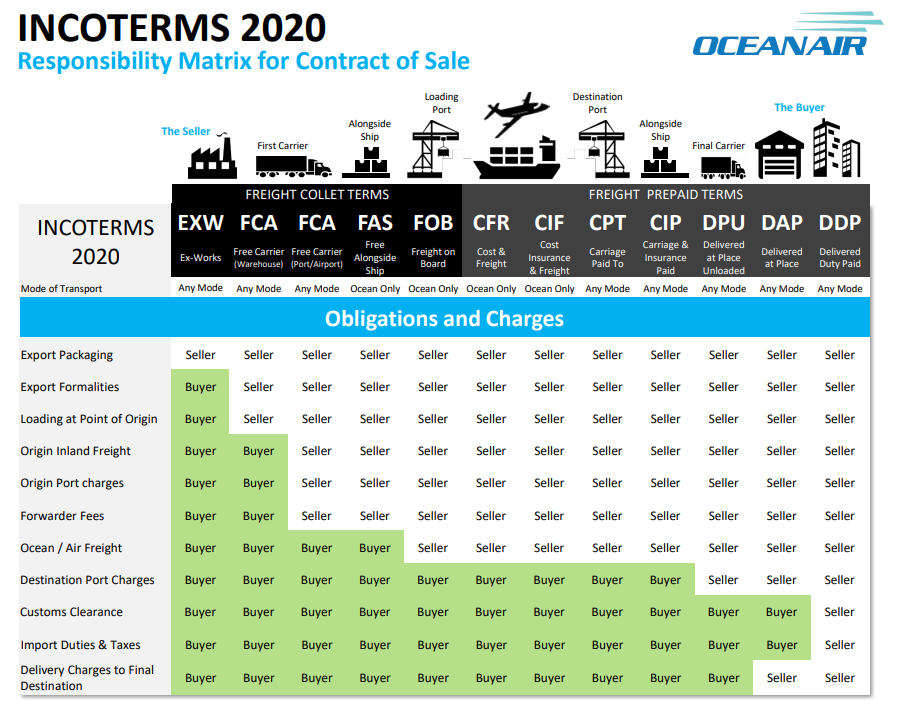
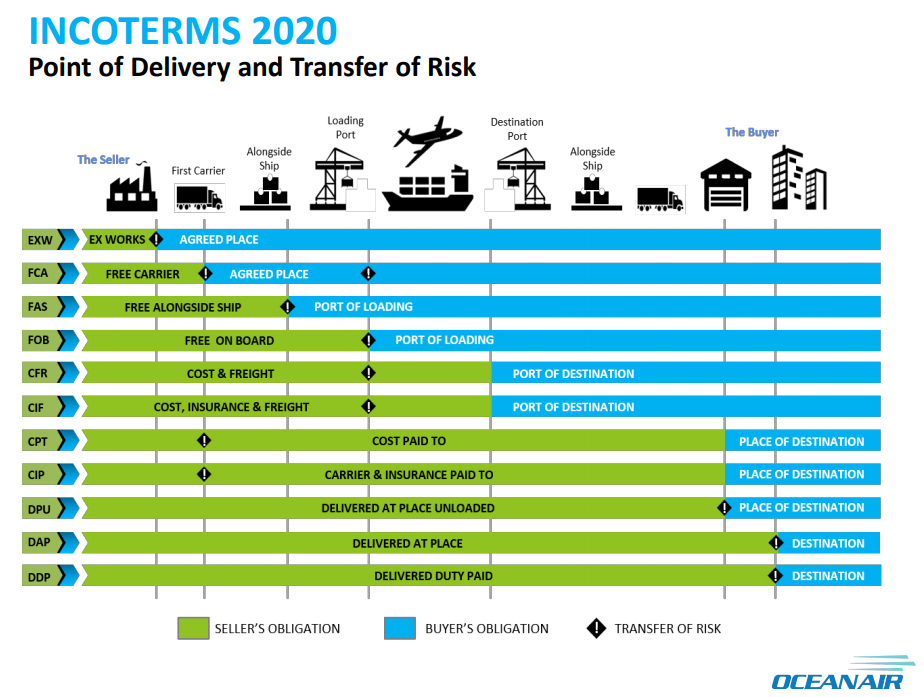
International Shipping
Clearly international shipping is an extremely complex area and this blog post only gives a very brief overview for common international commercial terms in relation to shipping. Hopefully this at least helps you to understand where your potential risks lie whenever you’re importing or exporting goods around the world.
by Michael Cropper | Jun 27, 2017 | Client Friendly, News |
You may remember the last product we launched, Tendo Jobs (https://www.tendojobs.com), the recruitment search engine that links employers directly with job hunters which is democratising recruitment. Since launching just over 12 months ago the platform has seen phenomenal growth with over 10,000 people having used the website during that time and attracting many well-known brands including the likes of the global taxi-booking platform Uber. This continues to grow month on month which is excellent to see. If you are recruiting and haven’t used the platform yet, we urge you to do so, it’s free and can be used as an additional tool for recruit candidates directly without the use of traditional and expensive recruitment methods.
Well, you’ll be glad to know that we’ve been busy working away in the background and are delighted to announce our latest product, GeezerCloud. This is a product that we’ve designed from the ground up to the cloud down, quite literally. Having been a chef myself for over 7 years in my early career, I can personally attest the laborious process involved with manually filling out printed sheets of paper while checking temperature records for fridges and freezers. Regularly checking temperatures is a critical part of food safety and is a legal requirement as part of HACCP within the catering trade, yet it needn’t be so time consuming and take a skilled member of staff away from preparing great food. That’s one of the reasons why we created GeezerCloud, to allow chefs to focus on what they do best, cooking awesome food and pleasing customers.

GeezerCloud is a hardware device coupled with a cloud based platform that is designed to automate the HACCP food safety legislation requirements for restaurants, those within the catering trade and further afield. GeezerCloud has been designed for commercial businesses that require regular temperature checks. Instead of manually filling out temperature checks on printed sheets of paper, GeezerCloud has been designed to fully automate this process for you, saving you significant amounts of time and money to focus on more productive activities.
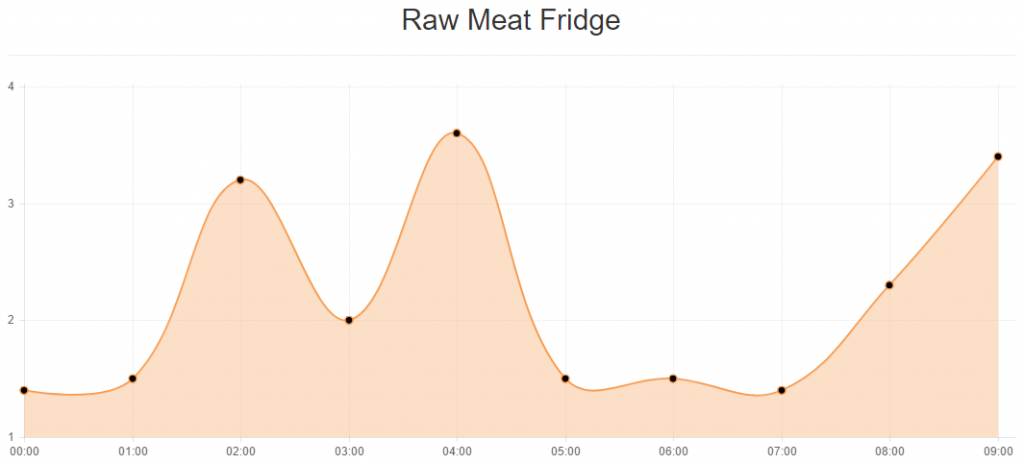
To avoid having to repeat ourselves within this blog post, have a good read through the finer detail about GeezerCloud along with our special introductory offer which is valid over the next 4 weeks.
Find Out More
by Michael Cropper | Jun 8, 2017 | Client Friendly, News |
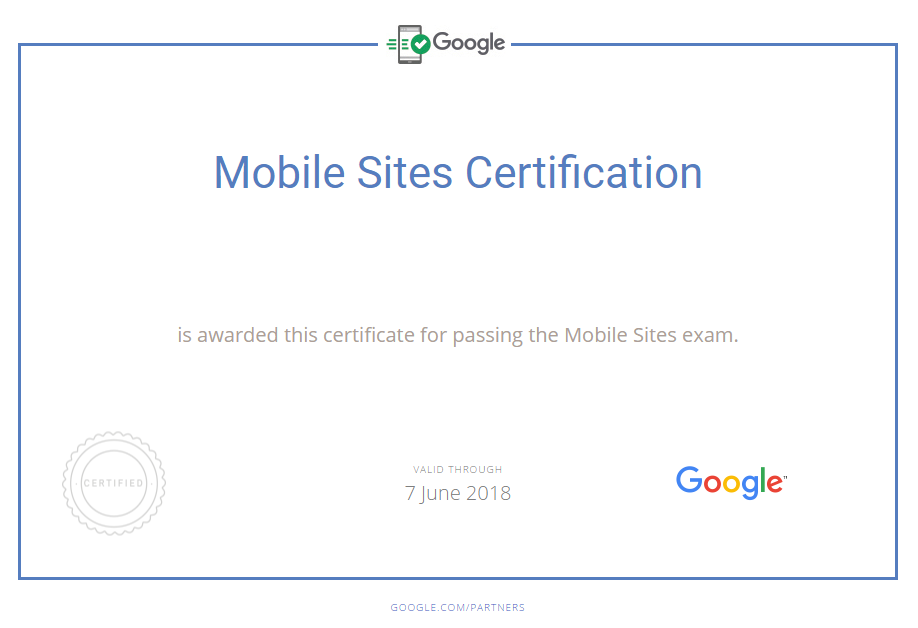 Well, this is a bit of great news for Contrado Digital. We’ve passed Google’s brand new Mobile Sites Certification and we believe we are the first in Lancashire to do so! This certification highlights that the mobile websites we develop are done to an extremely high standard to ensure your customers are happy customers when they visit your website. While what the non-technical users may just see as a “pretty website”, actually there is an awful lot going on behind the scenes, technologies, systems, processes, best practices and more that we know about so you don’t have to. We always say that any monkey can build a mobile website. Very few can build a mobile website that is designed to perform for your business. Whenever you are investing in a mobile website or a responsive website, make sure you are working with the right digital partner who knows what they are doing.
Well, this is a bit of great news for Contrado Digital. We’ve passed Google’s brand new Mobile Sites Certification and we believe we are the first in Lancashire to do so! This certification highlights that the mobile websites we develop are done to an extremely high standard to ensure your customers are happy customers when they visit your website. While what the non-technical users may just see as a “pretty website”, actually there is an awful lot going on behind the scenes, technologies, systems, processes, best practices and more that we know about so you don’t have to. We always say that any monkey can build a mobile website. Very few can build a mobile website that is designed to perform for your business. Whenever you are investing in a mobile website or a responsive website, make sure you are working with the right digital partner who knows what they are doing.
Want to chat about optimising your website for mobile devices? Then fill out your details on our contact form and let’s talk through the various options available to you within your budget.
The Mobile Sites Certification exam is designed to test your knowledge of advanced mobile website concepts, including the following:
- Value proposition of mobile websites
- How to improve mobile website speed
- How to create an effective user experience for mobile websites
- Advanced web technologies
- Module 1: Mobile sites and why they matter
- 1.1. Basics of mobile sites
- 1.2.1 User expectations
- 1.2.2 Impact on conversions and interaction
- 1.2.3 Why UX matters
- Discoverability
- Module 2: Improving mobile site speed
- 2.1.1 Tools to get started
- 2.1.2 Understanding low bandwidth and high latency
- 2.1.3 Targets to focus on
- 2.2 Critical rendering path
- 2.2.1 Constructing the document object model
- 2.2.2 The render tree
- 2.2.3 The layout
- 2.2.4 Analysing the entire CRP in dev tools
- 2.2.5 Optimising the critical rendering path
- 2.3 Optimise content efficiency
- 2.3.1 Eliminating unnecessary downloads
- 2.3.2 Optimising encoding and transfer size
- 2.3.3 Image optimisation
- 2.3.4 Webfont optimisation
- 2.3.5 HTTP Caching
- Module 3: Creating an effective mobile UX
- 3.1 UX principles
- 3.1.1 Assess your mobile site
- 3.1.2 Learn what makes a good mobile site
- 3.2 Mobile site design best practices
- 3.2.1 Homepage and site navigation
- 3.2.2 Site search
- 3.2.3 Commerce and conversions
- 3.2.4 Form entry
- 3.2.5 Usability and form factor
- 3.3 Testing and measuring success
- 3.3.1 A/B testing
- 3.3.2 Measuring success with Google Analytics and metrics to focus on
- Module 4: Advanced web technologies
- 4.1 Introduction to Accelerated Mobile Pages
- 4.1.1 What is AMP
- 4.1.2 How AMP works
- 4.2 Introduction to Progressive Web Apps
- 4.2.1 Why build PWAs
- 4.2.2 Introduction to the app shell architecture
- 4.2.3 Introduction to service workers
- 4.3 User engagement and APIs
- 4.3.1 Intro to web push and notifications
- 4.3.2 Payment integration
- Take the Mobile Sites exam
by Michael Cropper | May 15, 2017 | Client Friendly, Security |
Firstly to clarify, what happened to the people who have been impacted by the latest WannaCry Ransomware attack such as those having hospital appointments cancelled and suchlike is nothing short of a tragedy. I really do feel for the end users who have been impacted by this latest cyberattack that has spread so far and wide and has impacted people on a personal level. This rant below is not about the people who have been affected, this is about those organisations who quite simply have failed to protect their self against such threats due to poor security measures. Everything related to the latest WannaCry Ransomware attack is preventable.
Companies and organisations that have been impacted by the latest WannaCry Ransomware, I have one thing to say to you and that is that I honestly have no sympathy if you have been breached and have quite frankly failed to protect yourself. It’s the same situation whereby homeowners get burgled when they have left their front door unlocked and open, whereby car owners get their cars stolen in Winter when they have left the keys in the car running on the driveway for a chancer to take advantage of, whereby a car driver fails to wear their seatbelt, has an accident and injures their self. All of these things are preventable and most importantly, we all know what we should be doing in these situations so when the correct procedures and best practice aren’t followed, should we really have sympathy for those who have attacked by the latest WannaCry Ransomware?
Within 48 hours of being launched, WannaCry impacted over 200,000 computers in over 150 countries around the world. The WannaCry Ransomware was exploiting a known vulnerability in the Microsoft Windows operating system, a vulnerability that has been known about for at least 2 months publicly and much longer within the National Security Agency (NSA) which actually built a tool named EternalBlue which WannaCry is built upon.
This is a known vulnerability that organisations have simply failed to take seriously and act upon which is why I have no sympathy for those organisations impacted by the latest WannaCry Ransomware. The latest versions of Windows run automatic security updates and patches which means that as soon as vulnerabilities are known about, they are patched almost immediately and help to keep your company and organisation safe. In the situation with many of the NHS breaches, this comes down to computer systems and hospital hardware such as X-Ray Scanners running unsupported, vulnerable and unpatched versions of Windows XP. That’s right, an operating system that was launched in 2001, over 16 years ago, and has not been officially supported by Microsoft for over 3 years.
While organisations that have been impacted may indeed WannaCry while dealing with the fallout from this latest cybersecurity threat, personally I have no sympathy with those affected. Cybersecurity protection is a choice we all make. You choose either to protect yourself, or you choose not to. Clearly the right choice here is to protect yourself.
Have you been impacted by the latest WannaCry Ransomware? Then we can certainly help you resolve the issues your organisation is having and get you onto the right track to become a cybersecurity aware and secure organisation. Get in touch if you need help taking proactive measures to secure your business against cyberattacks.
You may have noticed, we take cybersecurity threats seriously which is why we ensure IT and web based systems are secure from cyberattacks. We help organisations like yours become a cyber aware and cyber secure organisation. We can only do so much ourselves, which is why we encourage organisations of all sizes to start investing in cybersecurity protection before you are the latest in a long line of statistics about the disruption and impact from cybercrime. If you don’t have the skills in-house to deal with issues like this, you need to be working with a company like ourselves to secure your business. You need to take the first step and reach out to IT security companies and ask them to help you to secure your systems. I write blog posts like this not to criticize and point fingers, but to raise awareness and encourage more businesses and organisations to become more cyber aware and secure.
We also sent out the email below to our mailing list who receive priority information on threats like this. If you aren’t subscribed yet, then make sure you fill out your email address in the footer.
WannaCry Ransomware and the NHS
As you will have likely seen on the news over the weekend there has been one of the largest Ransomware attacks in recent history which completely took offline the NHS, many local authorities throughout the UK and has now spread to over 150 countries around the world impacting over 10,000 organisations. As a business, you need to ensure you are protecting yourself against threats like this.
What is WannaCry and Ransomware?
WannaCry is the name of this specific piece of software that has been created by hackers which belongs to a group of cyber security threats known as Ransomware. Ransomware is when a piece of software holds your company to ransom by encrypting all of your data on your entire company systems (file systems, email systems, in-house servers etc.) and you can only gain access to this again by paying these hackers money for them to unlock your files. Money is often paid in cryptocurrencies such as Bitcoins as they are untraceable.
How to Protect Yourself Against Ransomware
Protection against threats like this is actually relatively straight forward. You must be taking proactive steps on a weekly basis to keep your IT systems up to date, patched and secure. Do not expect that either your IT person or your IT Support provider is handling this for you, you need to know exactly what processes are in place for these areas of protecting your business.
Secondly, staff training is extremely important to protecting your business from cyberattacks such as Ransomware. No matter how secure your IT systems are, if unaware staff open an attachment on an email or click on a link they believe to be genuine, this can bring down your entire company systems and stop work altogether. This in itself is not only costly in the form of not being able to work, it is even more costly to resolve situations like this after they have happened. Prevention and protection is always cheaper than the cure.
What to do Next?
As a business you should be investing in regular IT security support which helps to protect your systems from threats like this. This doesn’t have to break the bank either, the systems and technologies that are available today are a fraction of the cost they were 10 years ago which makes them affordable to businesses of all sizes. – Find out more
As a business you should be investing in regular staff training on cyber security threats to minimise the risk of one of your members of staff causing a damaging cybersecurity breach within your company based on lack of awareness. A workshop run at your premises or one of our group based sessions are prefect for companies of all sizes. – Find out more
We cannot stress this enough, when you are proactive dealing with cybersecurity threats, your organisation will be safer. Simply sticking your head in the sand and thinking that it will never happen to you has proven on many occasions to be a very bad decision and virtually always results in a cyberattack happening.
by Michael Cropper | Apr 13, 2017 | Client Friendly, Developer |
Blogging, content marketing, SEO, Google, brand building and more – We’re all told that blogging helps with all of these things, and it really does. But what if we want to turn blogging into a lead generating machine that you can highly target to your key audiences with different messages, all automatically? Imagine a mini-website-footer, that is fully customised to each of your target sectors and audiences that is filled with the key information to drive them to take the action you want on top of simply reading the blog post. Sounds pretty cool right? Well, yes, it is. And most importantly, it’s not actually that difficult to implement.
How WordPress Works
So, I’m going to assume you’re using WordPress for your blogging activities. If you’re not, have a word with yourself and get onto WordPress, seriously. There is rarely a reason to use anything other than WordPress for blogging activities in this day and age.
WordPress works in a very, well, WordPress way. So it is important to understand this in the first instance so you can understand what is actually possible. In essence, the end result for what we’re looking for is to add a bit of content at the end of every blog post, or every blog post within a specific category, or even every page on yourself. The options are virtually endless and allows you to customise what is important to you.
To get a feeling for the end result for what I’m about to show you, take a look at this blog post about How Travel Companies Can Stand Out on Googles Search Results Using Review Rich Snippets and most importantly, what you’ll notice at the end of the blog post is a small lead generation area that is designed to turn blog post readers into engaged people and potential customers at some point in the future.
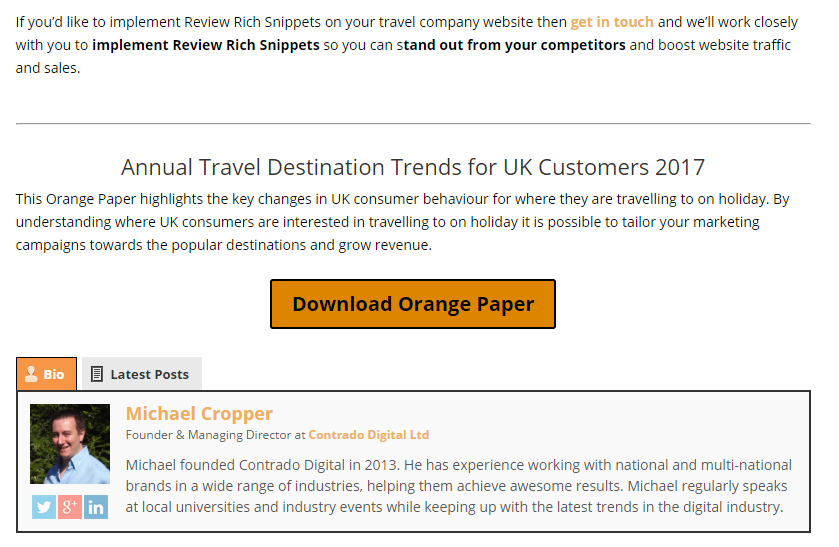
Specifically what you’re seeing above, is the last paragraph of the blog post, followed by the lead generation section, followed by the author section. And you’ll also notice that this section is not present on this blog post you’re reading right now, because this post belongs to a different target market, primarily developers like yourself reading this.
So, back to WordPress. WordPress works in sections. What you see is not simply a full page of content that is being generated in a single go, what is actually happening in the background when a blog posts loads for a user is that WordPress goes away and gets the header, the main navigation, the blog post content, the author information, the footer and many more things. In the background WordPress then pieces all of this information together which is then presented to the user in what they see as just another blog post on the website.
What is important to understand here is that you can interrupt this process and do additional things which is super handy. This is when you can listen out for Hooks and apply Actions and Filters to these Hooks. In essence, an Action does something, and a Filter changes some data in transit. It’s not always quite as straight forward as that in the background, but you get the idea.
If you’re a non-technical person reading this blog post, skim over the code and don’t worry about the finer details. Simple see the type of customisations that can be added to your WordPress blog posts to target your key target markets and generate leads.
Adding Lead Generation Content to the_content()
As mentioned above, there are many Hooks throughout the WordPress codebase. One of these is called the_content() which provides, you guessed it, the content on the page. In this specific example, the blog post content. And because this Hook exists, it is possible to manipulate the data, for example by adding additional information at the start or the end of the blog post content.
What is interesting too though is that every blog post belongs to a specific Category, which again can be used to show different information at the bottom of blog posts that belong to different categories. For example, if you wanted to share different information with people reading technical information VS non-technical information or share different information to people within your different target markets, this is all possible and this is exactly what we’ve done on our website.
So, let’s jump straight in and look at the code and I’ll explain everything in a moment.
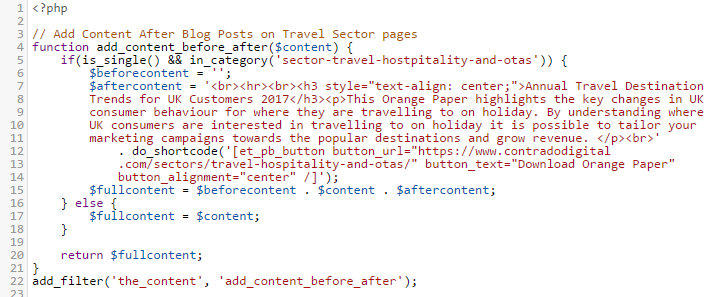
The above code is contained within the functions.php file within our Child Theme. In essence what the code is doing is listening out for whenever the_content() Hook is triggered by WordPress, i.e. when someone is looking to read a blog post, then before this information is sent to the user, it is being altered slightly. As the_content() Hook is triggered for both Posts and Pages, the if(is_single()) part is saying that only apply this lead generation content on Blog Posts, not Pages. And likewise, the in_category() part is saying only display this information within this specific category which is the URL slug of the category, not the name of the category.
The $content variable is where all the information for the content is stored. So we want to add data to the start and end of this. In this example, we’ve only added data to the end, although both have been contained to show you the logic of how to add content either before or after the_content() part. Reading through the code should be relatively self-explanatory when you compare with what you can see on the main image at the top for how this is displaying. The only thing to point out specifically is the additional do_shortcode() function which is also called which allows us to output shortcodes from here too rather than just plain text. This can be really handy if you want to add things like buttons and forms before or after the content. When you do this, note the single VS double quotes. Make sure you don’t get these in the wrong order or it won’t work.
And it really is as simple as that. Turn your blog posts and content marketing activities into lead generating machines without manually adding this information at the bottom of every blog post you write, which is extremely time consuming to change in the future as you fine tune your marketing campaigns.
by Michael Cropper | Apr 13, 2017 | Client Friendly, Sector - Travel, Hostpitality and OTAs, SEO |
Travel is a competitive market, so it is important that your brand stands out from your competitors when customers are searching on Google for queries such as “Holidays to Kefalonia” and similar review type queries. Rich snippets are a great way to highlight your brand amongst your competitors which can generate additional traffic to your website from Google, leading to increased sales and enquiries.
So what are Review Rich Snippets and when do they show?
Rich Snippets are a form of structured data that simply helps Google to understand what the content on your website is about. There are Rich Snippets for a variety of areas and the one we are going to cover today is specific to highlighting review information on Google. What this means in practice is that when customers are searching for queries such as “Holidays to Kefalonia” or “Holidays to Kefalonia Reviews” there is a greater chance that Google will highlight your website with stars next to your listing as can be seen in the image below;
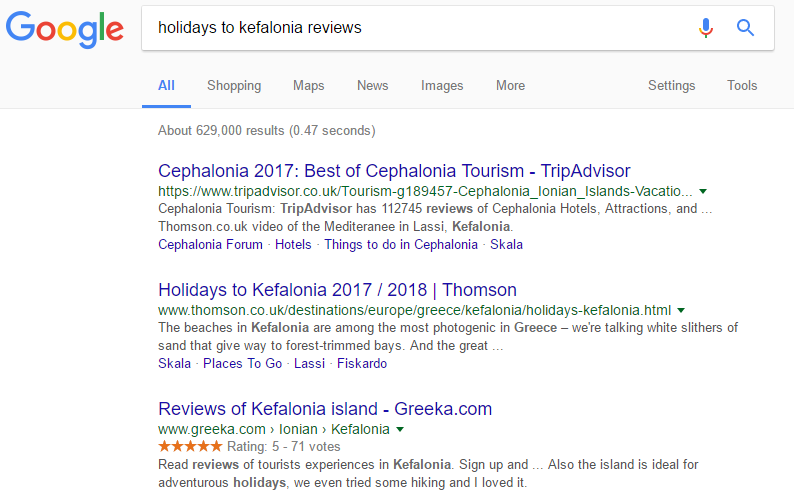
As you can see here, your eyes are instantly drawn to the listing that stands out from the others with the star ratings. In essence Review Rich Snippets require each individual Review to be marked up along with aggregating this data into an overall review based on all the review data. This information can be from your previous customers who have been on one of your holiday packages, so it is essential to be collecting this data from your customers at the earliest available opportunity.
How to Mark Up Review Rich Snippets
There are many ways to marl up Review Rich Snippet content which gets rather technical, so we’re only going to skim over this information as we don’t want to bamboozle you with the finer technical details. For the purposes of this blog post we’ll use the Greeka.com website as an example and take a look at what they have done to implement Review Rich Snippets on their travel website.
Firstly what you’ll notice when you visit their website is a listing of review information as you would expect to see as a user;

What’s important to note here is two pieces of information. Firstly, you will see the overall reviews listing at the very top which states that there are 71 reviews in total with the average being 5/5 for the reviews that have been left. Then beneath that you’ll notice an individual review that has been left by a customer. As a user, you’ll never notice Review Rich Snippets are there which is exactly why they exist. Review Rich Snippets for travel websites are in the code in the background which is telling Google that there are reviews associated with this specific item such as a holiday package, a resort, a restaurant or a specific hotel for example.
Here’s what this looks like in the background, the code below relates to the aggregate reviews which are what is showing on Google;

What you’ll notice is that there has been specific pieces of code wrapped around the content on the page which state that the destination has an average review of 5/5 from 71 people. When you read through the code you’ll notice there are specific pieces of information such as ‘best’ and ‘average’ and ‘votes’ etc. It is this information and more that Google is using to generate the visible star ratings on the Google search results that customers see when they are searching for travel companies.
Likewise you’ll also notice when reading through the code on the page that each individual review also has specific Review Rich Snippet data marked up around it too as you can see in the image below;

With information such as ‘reviewRating’ and ‘worstRating’ and ‘ratingValue’ for example being some of the key pieces of information Google requires to be able to see how the overall review ratings have been calculated.
Ok, that’s enough code for now. In essence, to get Review Rich Snippets and star ratings showing on Google it is important that you implement the code correctly which ties in closely with the technology that is powering your website. There is no one-size-fits-all approach here as every website is different.
If you’d like to implement Review Rich Snippets on your travel company website then get in touch and we’ll work closely with you to implement Review Rich Snippets so you can stand out from your competitors and boost website traffic and sales.





 Well, this is a bit of great news for Contrado Digital. We’ve passed Google’s brand new Mobile Sites Certification and we believe we are the first in Lancashire to do so! This certification highlights that the mobile websites we develop are done to an extremely high standard to ensure your customers are happy customers when they visit your website. While what the non-technical users may just see as a “pretty website”, actually there is an awful lot going on behind the scenes, technologies, systems, processes, best practices and more that we know about so you don’t have to. We always say that any monkey can build a mobile website. Very few can build a mobile website that is designed to perform for your business. Whenever you are investing in a mobile website or a responsive website, make sure you are working with the right digital partner who knows what they are doing.
Well, this is a bit of great news for Contrado Digital. We’ve passed Google’s brand new Mobile Sites Certification and we believe we are the first in Lancashire to do so! This certification highlights that the mobile websites we develop are done to an extremely high standard to ensure your customers are happy customers when they visit your website. While what the non-technical users may just see as a “pretty website”, actually there is an awful lot going on behind the scenes, technologies, systems, processes, best practices and more that we know about so you don’t have to. We always say that any monkey can build a mobile website. Very few can build a mobile website that is designed to perform for your business. Whenever you are investing in a mobile website or a responsive website, make sure you are working with the right digital partner who knows what they are doing.




